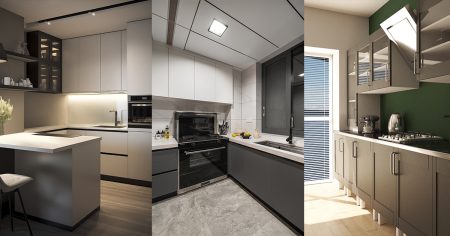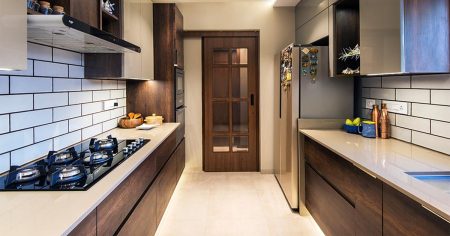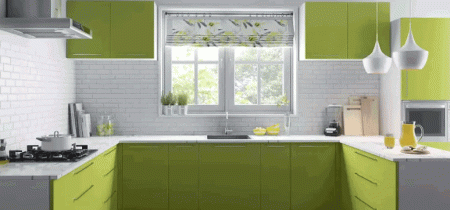When designing your kitchen remodel, it might be tempting to ignore spacing and placement recommendations for islands, seating, and appliances. Recommendations are not mandatory building codes but guidelines that come from the National Kitchen & Bath Association’s (NKBA) Kitchen Planning Guidelines.
These recommendations apply to key areas of your kitchen such as kitchen layout, how far an island should be located from cabinets and countertops, the width of walkways, seating clearances, and the placement and spacing of appliances such as dishwashers. Here are a few common guidelines.
| Space | Distance (Inches) |
| Distance between island and counter | Minimum 42 inches usually or 48 inches for kitchens with 1+ cooks |
| Walkway space | Minimum 42 inches near a work area or 36 inches elsewhere |
| Dishwasher to sink | 36 inches maximum |
| Kitchen bar seating | 32 to 44 inches, depending on exact location and amount of expected foot traffic nearby |
Understanding the Kitchen Triangle Work Area
The umbrella recommendation for implementing a kitchen design is the kitchen triangle. The kitchen triangle is a design concept recommending the position of the three most important work areas—the sink, refrigerator, and stove. The recommendation is to position the three items in a triangular fashion to minimize the distance you would have to travel to reach each “zone.” The triangle is designed for efficiency and comfort. For example, moving between the sink, refrigerator, and stove to the prep area can be tiresome and inefficient if the distances are too far apart or too crowded.
The kitchen triangle has many variations, as long as the three “legs” of the triangle are kept in check and add up to the recommended total. Leg measurements are not set in stone nor are they part of a building code, they are simply recommendations to keep the distances well-balanced. Here are kitchen work triangle guidelines:
- All three legs of the triangle should ideally total 26 feet or less.
- No individual leg should be more than 9 feet (too far apart).
- No individual leg should be shorter than 4 feet (too restrictive).
Distance Between Kitchen Island and Counter
Within the confines of the work triangle are other distances to consider, such as how far apart the island and counters against the walls should be. Kitchen island clearance is important because some kitchens may not be large enough to have an island. The recommendation is to have a distance of 42 inches to 48 inches between the perimeter countertops and the kitchen island. If your oven opens into the work aisle, you will usually need 48 inches of clearance space.
Kitchen Walkway Spaces
There is also the walkway to consider, where passersby go through the kitchen. A walkway is not part of the kitchen triangle because it is not part of the kitchen’s working and prep area. The recommended minimum width for a walkway is 36 inches, but a walkway can be as wide as you wish.
Kitchen Seating Clearance Recommendations
Kitchen seating clearance recommendations are also flexible and can be adapted to your needs. If you have a breakfast bar or an in-kitchen eating table, make sure your chairs have a minimum of 32 inches (not ideal for foot traffic) to 44 inches (better for foot traffic) from the chair back to the wall or counter. Wheelchair access requires at least 60 inches of clearance space.
Dishwasher Spacing and Placement Recommendations
Dishwashers and sinks can easily get crowded since they need to be close in proximity to take advantage of their shared drainage and water supply.
- Dishwasher to sink distance: The distance between the dishwasher to an adjacent sink should be a maximum of 36 inches. This allows easy transport of dishes from the sink to the dishwasher and keeps the under-counter water hookups close.
- Dishwasher to base cabinets distance: The dishwasher should have a minimum of 21 inches of space between it and the nearest base cabinets or other obstructions to give the door plenty of room to open freely without hitting handles or other objects.
Adding a Kitchen Countertop Landing Area
A kitchen landing area is a countertop space next to the sink, refrigerator, cooking surface, or oven that lets you safely place items. For example, if you do not have a landing area near a stove or oven, you may be tempted to place a hot pot or pan in a close but unsafe spot. Here are some rough kitchen countertop landing ideas and guidelines:
- Sink landing area: 18 inches to 24 inches on each side for placing dishes to dry or that need to be washed
- Refrigerator landing area: 15 inches on the side of the fridge that has the handle (for a single-door model) so you can easily place items that need to go into or out of the fridge
- Cooking surface landing area: 12 inches to 15 inches on each side for hot items and ingredients used for cooking
- Oven landing area: 15 inches adjacent to one side, both sides, or on the counter above the oven for hot items and ingredients used for cooking
-
What size kitchen is too small for an island?
To fit a small 2-foot wide by 4-foot long island, your kitchen should be at least 12 feet wide by 8 feet long. A narrow island will not typically accommodate an eating area or built-in appliances. However, you can certainly have a custom island made for under 24 inches wide to give you valuable additional counter space. It will also help to have a French door-style refrigerator (doors have a shorter swing) for adequate clearance.
-
What is the width of most kitchen islands?
A kitchen island should have a minimum width of 2 or 3 feet.
-
Where should you never put a refrigerator in the kitchen?
Do not put a refrigerator near the oven or stove because the heat will make the fridge work harder to stay cold. Having a fridge in a high-traffic area is also not ideal since an open door can block the aisle.
-
What is the minimum clearance around a kitchen island?
Clearance around kitchen islands is crucial, and some kitchens are just not big enough to house an island safely. At a minimum, there should be at least 42 inches of space between a kitchen island and the nearest countertop. If you have an oven that opens into this space, you will need even more room, at least 48 inches.
Read the full article here














